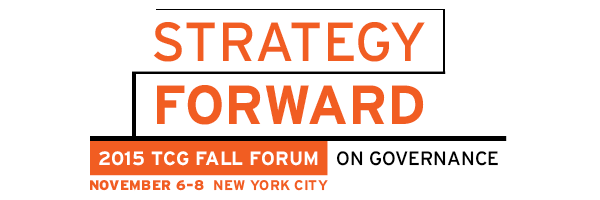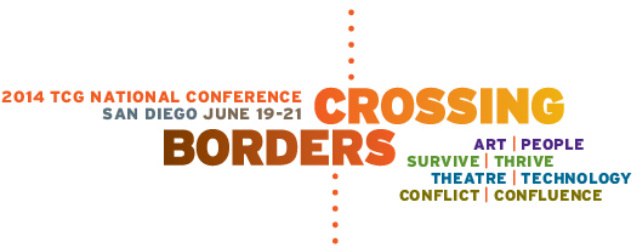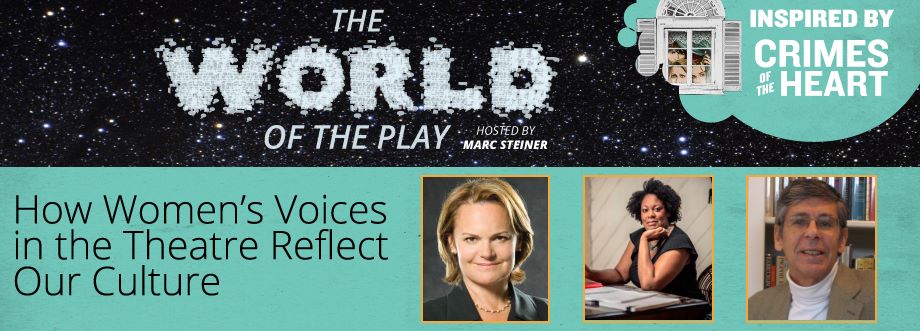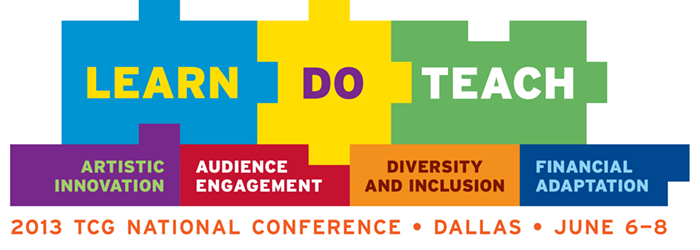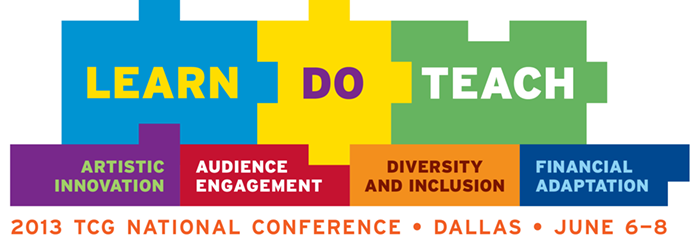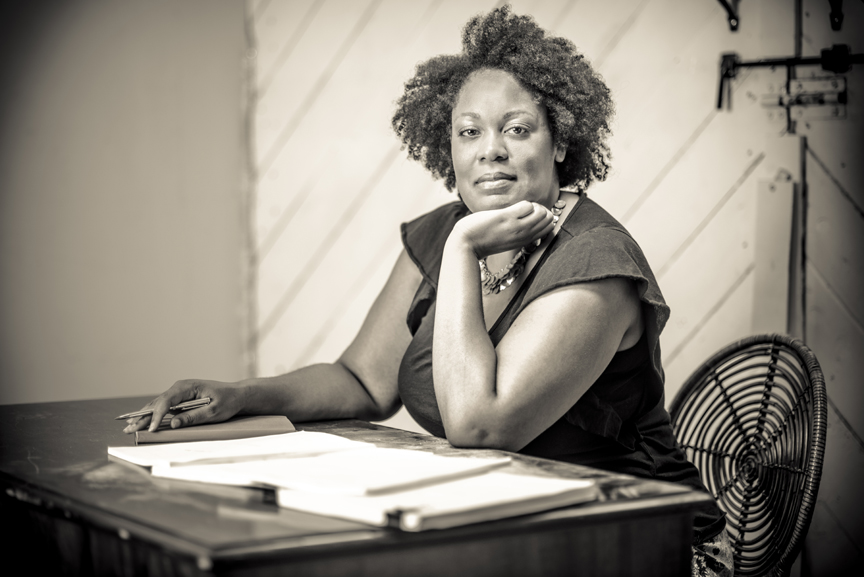|
On Thursday, I head to New York to take part in TCG's Fall Forum on Governance, which gathers theatre trustees and senior staff from around the country. This will be my third Fall Forum and I remain as interested as ever in the learnings made during these meetings. The purpose of this convening is threefold:
This year's theme is Strategy Forward and our guiding questions will be:
As I think about the work ahead, I'm reminded of a recent Facebook conversation between colleagues discussing transitions in artistic leadership in the D.C. theatre community, which highlighted that the last time a woman was selected to lead a major regional theatre was in 1998 and that was at Arena Stage. Since then, Olney Theatre, Round House Theatre, and Theater J have seen leadership transitions go from man to man. None of them of color. (Studio Theatre went from a woman to a man. Center Stage in Baltimore, MD went from a woman to a man, specifically, to a man of color.) Having just served on a Producing Artistic Director Search Committee at a major regional theatre, I will say that the makeup of your board/search committee and their commitment to Equity, Diversity, and Inclusion are of the utmost importance during transitions of power. They must be committed to the theatre's mission; knowledgeable of issues impacting the local, regional, and national theatre communities; aware of the needs and contributions of the staff; excited by a vision for the future; and not afraid of the great change necessary to make all of this happen. In other words, your fundraising and advisory boards must be peopled with change makers and their investment in your organization must be tied to the health, growth, and sustainability of the community you serve. All of which is easier said than done, of course, but absolutely necessary. We are at a time in our country and world where great change and new ways of thinking are essential for survival. We need a tide of reckoning, a wrestling with our unconscious bias towards race, ethnicity, gender, class, religion, and ability when it comes to leadership and representation. It will be interesting to see what happens at Shakespeare Theatre Company, Signature Theatre, and Woolly Mammoth Theatre Company...as well as other regional theatres across the nation.
0 Comments
Recently, I've been in a number of conversations with playwrights interested in learning how to find an agent. When asked this question, I always share the advice that Beth Blickers gave to me when I first approached her about five or six years ago. At that time, I was working freelance as a playwright, dramaturg, director, producer, and teaching artist. I was juggling a lot of contracts and working hard to find balance in my life. I already had several readings, workshops, and productions to my name. What's more (and by the grace of all the muses, word of mouth, and good networking), my plays were being read by artistic directors and literary managers at some rather exciting regional theatres. I was eager to become a part of the American Theatre in a more visible and viable way. Beth, being the wise and generous playwrights' angel that she is, read three of my plays and was excited by my voice. She put me in her back pocket, as it were, and told me to be patient. She offered me excellent counsel from time to time and introduced me to a number of folks who also took an interest in my work. Each time we connected, she told me to focus on my craft. I did and years later, but exactly on time, an amazing agent, the incomparable Morgan Jenness, found me. Officially, Morgan and I met at the 2012 TCG National Conference. I was there for the first time as a Young Leader of Color and she was my mentor. Morgan is someone who doesn't do anything in halves. We spent a year getting to know each another over lunches, emails, and at various conferences. She is someone I cherish deeply. We have similar values. I deeply admire and respect her fierce commitment to arts advocacy and social justice. In her actions and belief in me, she encourages me to be a better person. When she left Abrams Artists Agency, she made sure that I was in good and capable hands, which is how I came to work with the remarkable and talented Leah Hamos, who has been my source of strength, courage, and stability ever since. So, for me, finding an agent was about finding a mentor, collaborator, and friend. It also had to do with shaping my voice, continuing to network, strengthening my position in the local, regional, and national community, and determining what my specific contribution to the American Theatre would be. But every story is different and so, without further ado and with permission, here's the invaluable advice that Beth Blickers shared with me: When to Approach an Agent by Beth Blickers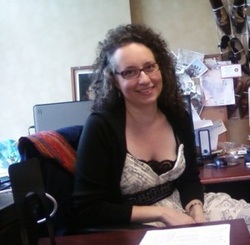 “If you’ve only written one play and it hasn’t been produced then it is decidedly too soon to look for an agent. And bear in mind that once an agent passes on repping you, you go into their database of people to whom they have said no. And I know for a fact that at some agencies that database is shared within the department. Meaning if you get told no by one agent and approach a different agent two years later, they look you up and you can wind up getting passed on again without being read afresh. The strongest moment to reach out to agents is when something nationally recognized is happening in your career, when you’ve built of fan base of people who know agents and can speak highly of you and when you are starting to bring in some income so they aren’t working entirely for free. At this point you’ll probably have met some agents in passing at theaters and panels, you’ll probably have worked with some directors who have agents (and are easy ways to get introductions), you’ll have artistic directors and literary managers who will make introductions on your behalf. And I hope you will have talked to represented artists about who they are with, who they know, who they like and why they like them, what agents are actually able to do for them, how they work well together (or don’t), so that you can thoughtfully talk with some agents and make a choice and work together happily for many decades to come. Don’t (and I’m sure every literary manager will second this list) send us a play you have never heard out loud, even if it’s just in your living room. Don’t tell me about the 22 full length plays, 78 one acts and 592 sonnets you’ve written. Don’t list all of the famous people you know if they’ve never done a thing to further your career. Don’t tell me you’ve been produced by a theater when it was a one night event. Be honest and straightforward. I’d rather a fairly empty resume with a genius cover note then a dazzling array of information that when I start to pick at it, falls apart like dust. And trust me, we check. If you tell me a theater is strongly considering your play I WILL ask that theater about it. And 99 times out of 100 the “strong consideration” means the writer sent them the play that week. Makes the writer look bad to me and the theater. Do network like mad, go to new play festivals, offer people a mid afternoon iced latte in exchange for an informational meeting, Google theaters, have a website, befriend writers and directors, invest energies in things other than theater, be interested in the world around you and be an interesting person yourself. Know what makes you unique and what you have to offer to the world of theater. The other day I chastised theaters who respond to queries about what they are looking for in a play with “good writing.” I’d say the same to any artist. If I ask you want you want to do in the theater please don’t tell me “write good plays and work with good people.” It tells me nothing about what makes YOU special. And if you don’t know what makes you special why do I care? To quote the great Liz Engleman “why this play, now.” I’d expand that and say agents are asking daily “why this writer, now.” The best writers have an answer. And my goodness they are a delight to represent.” Beth Blickers is currently an agent at Abrams Artists Agency, where she represents such writers, composers, directors and choreographers for theatre, television and film. Before joining Abrams, she was an agent at Helen Merrill Ltd. and the William Morris Agency, where she began work after graduating from New York University.
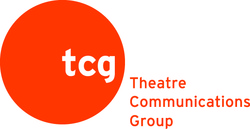 In just two months, the 24th TCG National Conference: Crossing Borders will take place in San Diego from June 19-21, 2014. I can hardly wait! Each year, the conference offers an opportunity to see friends, meet new colleagues, learn from presenters, and engage in dialogue that will help shape the future of the American Theatre. Building on the success of the programmatic arcs from the 2013 TCG National Conference: Learn Do Teach in Dallas, the conference will focus on four main areas of exploration: Art | People: How are relationships changing between theatres and communities? Survive | Thrive: How can we move our financial practices from surviving to thriving? Theatre | Technology: How can the live arts better engage with our digital culture? Conflict | Confluence: How can we have productive conversations about difference? To make these arcs even more intentional and impactful, TCG will host a series of online salons on their blog, the TCG Circle. Over the next couple of months, I'll be curating salon around the following arcs: {Theatre | Technology} How can the live arts better engage with our digital culture? As the rate of cultural change from disruptive technologies increases, its impact is often seen as detrimental to theatre and other live arts. Yet many theatres are harnessing those technologies—through marketing resources, backstage tools and in the work itself—to innovate and strengthen their programming and infrastructure. {Theatre | Technology} sessions will ask big questions about crossing the boundaries between the live and the digital, and trade nuts and bolts tactics for taking advantage of the latest technological advances. {Conflict | Confluence} How can we have productive conversations about difference? Let’s face it: in the theatre field, we disagree as often as we agree, and those disagreements often shed more heat than light. How can we create space for the taboo topics and difficult conversations we need to have: between departmental silos, between funders and institutions, between all our intersections of diversity? How can conflict of ideas lead to positive growth? Participants attending {Conflict | Confluence} sessions will not only learn strategies for managing complexity and difference within their own institutions, but also together reimagine some of the most significant perceived barriers that divide our field. Additionally, I'll be continuing each of the blogs related to TCG’s Diversity & Inclusion Initiative:
If you'd like to contribute to any of these salons–and everyone is invited to participate–please email me and I’ll send you more information. 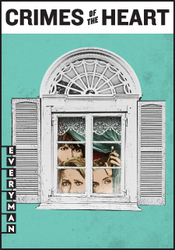 On Saturday, January 18th at 5:00pm, Everyman Theatre will host a panel discussion on How Women's Voices Changed Our Culture in conjunction with the production of Crimes of the Heart. Hosted by radio personality Marc Steiner, panelists will include: Teresa Eyring (Executive Director, Theatre Communications Group), Jacqueline Lawton (Playwright and Dramaturg) and Jackson Bryer (Professor of American Theatre, University of Maryland). Click here to listen to the podcast. "The World of the Play is a new panel discussion series at Everyman Theatre. With the program we aim to promote cultural dialogue within the community, providing access to conversations with experts, professionals, and academics, relating to the themes and broader relevance of a given Everyman production. Everyman is beyond excited to welcome the highly distinguished panel of guests for the discussion inspired by Beth Henley's Crimes of the Heart. We live in a time that has been dubbed, ‘The Age of the Playwright’, examining the presence of the American female voice in this declaration is as pertinent as ever. We hope to provide a platform on which panelists and participants can interrogate the intricate dynamics between gender, art and culture." said Everyman Theatre Education Director Nora Stillman Burke Crimes of the Heart debuted in December, 1980 and became a swift success for playwright Beth Henley. The Pulitzer Prize-winner provided great leading roles for many great actresses. However, over 30 years later, plays written by women are still produced far less than plays written by men. To this day, less than 15 women have won the Pulitzer Prize for Drama. In this discussion we will use the legacy of Beth Henley's Crimes of the Heart to discuss the role of women play in theatre today. Contemporary playwright Jacqueline E. Lawton will provide living expertise as a current playwright. And Jackson Bryer will provide historical perspective as a professor of American Theatre at the University of Maryland. "I’m excited to participate on this panel, in my hometown of Baltimore where my love of theatre began," shared Eyring. "I am also passionate about the topic. I’ve been fortunate to be given extraordinary opportunities in the American theatre field, including in my current position as the first woman to head the 52 year old Theatre Communications Group. Many of the most significant artists and producers working in theatre today are women, and I am honored to be a part of an important conversation about opportunities and issues for women in the field.” "I first read Beth Henley's Crimes of the Heart when I was an undergrad and I've held a deep respect for it ever since." said Lawton. "I admire not only how Henley addresses the role and expectations of women in society, but also how she allows the sisters to have an awareness and access to her sexuality. Additionally, I appreciate the respectful way that race relations and depression are addressed in this play. I'm excited to take part in this panel and to have the opportunity to explore these issues in depth." Click here to listen to the podcast.  Everyman Theatre is an intimate Equity theatre with a resident company of artists from the Baltimore/Washington area, dedicated to producing quality plays that are accessible and affordable to everyone. Everyman Theatre is a professional Equity theatre company celebrating the actor, with the resident company of artists from the Baltimore/DC area. Founded in 1990 by Vincent Lancisi, the theatre is dedicated to engaging the audience through a shared experience between actor and audience seeking connection and emotional truth in performance. This video is powerful and evocative. It moved me to tears.
Here's how it is described: "A blind and homeless man sits by the side of a building hoping for some spare change, but no one seems to notice him or care. A stranger walks by and changes the message on his sign and suddenly the homeless man's fortunes change." But it's not a PSA in support and awareness of the homeless and/or disabled communities. It's an ad for online copy writers. Thank you, A. Rey Pamatmat for sharing this useful bit of dramaturgy. Confession: I silenced the little voice in my head that said, "Wait a minute, she didn't even ask if she could change his sign." I did so, because I found the compassion of people giving so touching. I have a heightened awareness to the homeless community right now for a number of reasons:
Mind you, using the poor and disenfranchised to evoke compassion is nothing new and it's where things get tricky. Also, let's contemplate this woman's action to change his sign. It reminds me of a scene in Episode Six of the ever brilliant House of Cards when Claire Underwood sees a homeless man perched outside of her office and hands him a $20 bill. She tells him there is a cafe up the street and walks away. We see him look at the money, but he does not move. The next day, he returns the $20 bill to her as a beautifully folded crane. She takes the crane, contemplates it and learns how to make cranes of her own. I'd also like to think that Claire sees this man as a man and as someone for whom she should not make assumptions. Also, I hope we get more of him in this next season. There is a space where the women in the video's actions could be applauded. She didn't just walk by or drop of a few coins. As someone good with words, this is what she could do or give. In my own arrogance, I have seen the signs of the homeless or experienced the pitches, and wanted to offer a few tweaks. Historically, much has been made of this space of not just giving, but of doing what you can. Colonialism is a result of this space as are the many welfare programs in this country. And it is here where I want to focus this conversation, this space of knowing what is best for a community and therefore providing a service. It's troublesome as it relates to the work we do in theatre when we provide artistic programming FOR a community and not WITH the community. With theatre, we are creating what we believe is a deeply powerful, important, and meaningful experience. But within that is the knowledge/working assumption that the community doesn't know what it needs and/or that it needs to be taught, and certainly that it needs to be taught a standard of excellence. But we are surprised and disappointed when the community doesn't show up, and because of our business model and need for sustainability, we are also panicked. We do our best to try to engage with the audience: surveys, post show discussions, marketing, etc. But something is missing. There is a disconnect in all of this somewhere. I decided to write about this, because I've been a part of conversations about how in the nonprofit theatre world, we serve our communities by providing artistic programming for them versus with them. This is subtle, but marked distinction. Also, I've been a part of conversations about how theatres use people of color in their marketing, but their programming and artistic/administrative staff do not reflect the same level of diversity. There is a disconnect between the mission statement, the programming, and the community, which could account for dwindling audiences, the continued lack of diversity, and no doubt contributes to unstable capitalization. Click here to learn more about how all of this is intertwined. There's so much to unpack here. I thought about deleting the video from my Facebook page, but felt the conversation was relevant and important to have. I look forward to hearing your thoughts. I'm back from TCG's Fall Forum on Governance, an event that brings together theatre trustees and senior staff from across the nation. This year's theme was “Investing in Vitality: Actions Plans and Honest Dialogue to Strengthen Capitalization and Diversity.” We spent the weekend discussing how a strong business model rooted in diversity and inclusion and based on a long-term financial plan will better serve a theatre’s company's mission, vision and purpose as well as its community. It was a powerful, engaging, informative and emotionally/politically charged convening that focused on intersection of diversity, inclusion, artistic freedom and financial health. I’ll be capturing my notes and reflections on TCG Circle’s Diversity and Inclusion Salon. By Sunday evening when I arrived at Penn Station, I was exhilarated, but exhausted. I was also in pain from having sustained an accidental self-inflicted hot water second-degree burn on my thumb. Don't worry, I’ll spare you the details and photo! The train was 45 minutes late and overcrowded. Couples and families were split apart and strangers were seated side-by-side. Most folks plugged into electronic devices right away. All around me, people were listening to music, watching movies, working on spreadsheets, writing reports and sending emails. I thought about working, but couldn’t summon the focus or strength. Instead, I rested and thought about the uncertainty and exciting possibilities that lay ahead. Doing so, allowed me to overhear a touching and unexpected conversation between the two men seated in front of me. One was older, in his late 30s, the father of a 7 year old girl. The other one was a junior in college, in his early 20s. The conversation began in Trenton, where the Young Man had boarded. My ear picked up their conversation when the Young Man started speaking about the differences between Princeton and College Park as college towns. The Young Man was from a small town in the Midwest and then had transferred from UMD to Princeton in August. He was still trying to get used to everything. After spending most of my life in a farming/cattle ranch community, before attending undergrad and grad school in Austin, TX, I understood what he meant by getting used to everything. Austin is great college town, but it’s also a big music town that hosts the ever-popular SXSW Festival, has a lot of great food and excellent outdoor activities. While worlds apart in many ways, both College Park and Princeton have beautiful scenic campuses, are peopled with brilliant, accomplished and creative minds, and rest in close proximity to the nation’s most exciting, international cities. The Older Man suggested that part of the Young Man's trouble was that New Jersey has an identity problem. “Princeton is a great school, one of the best schools, but I would never want to live in Jersey. But because of work, I’ve spent time in a few major cities and the shore. One on one, New Jersey has some nice cities, as beautiful as any city in America. But, for some reason, somewhere along the way, the state got a bad reputation and it stuck. You know, the whole armpit thing” The Older Man then recommended that the Young Man take a few weekend trips to New York and mentioned that the last time he was there, he saw Avenue Q. This, as you can imagine, delighted me to no end. Usually, I'm the person on the train that tells strangers to go see theatre in various cities. Now, the Young Man had never heard of Avenue Q, so the Older Man explained that it was an irreverent “parody, riff, take” on Sesame Street. “Instead of counting and the ABC’s, we learn that everyone is racist and sexist and that we’re all basically good people who do bad things sometimes and have all kinds of issues. It was the funniest, smartest thing I’d ever seen.” The Older Man then asked the Young Man if he had ever watched Sesame Street. The Young Man replied, "Of course, I grew up on it." The Older Man confessed that he hadn't watched it growing up, but does now with his daughter. Then, he started talking about the puppetry of the Lion King and tried to connect with regards to the history of puppetry. He wasn't quite getting right, which made me want to interject and launch into my Intro to Theatre lecture about the history of puppets and the impact of The Lion King on puppetry in the American Theatre, but I didn’t and I'm glad. If I had, it probably would've prevented what became the most amazing unscripted conversation I've ever eavesdropped on in my life. When talk turned to the Lion King, the Young Man got excited, because had seen it with his parents. They talked about how the Broadway production was so different and even more beautiful than the movie. The Older Man shared that he thought Scar was a terrible villain, because he killed his own brother to be king. To this, the Young Man adamantly disagreed. He thought Ursula from the Little Mermaid was "the worst person in the world. Well, not person, but character. She's pure evil. To see that people are weak and lonely, to make promises to help them, to make impossible bargains, knowing they won't be able to ... and then to take their lives. That's just wrong. I hate her so much." He got deeply emotional when he spoke. His voice rose, but also quivered in timber. It made me think he had met his own Ursula at some point in his life. The Older Man agreed and said he would make sure to talk to his daughter about that when they watched it again. From there, they launched into the most compelling and detailed conversation about princesses from the following Disney Movies: Aladdin, Snow White, Beauty and the Beast, The Little Mermaid, Cinderella, and Sleeping Beauty. They spoke passionately and at great length about the trajectory of each woman: what they had wanted, the villains they had to face, the challenges they overcame, and what they learned/how it changed them. In the end, they determined that Belle was the absolute best of all of the Disney princesses, because she was smart, liked to read, was patient and kind to her father, was a little weird, didn't want to do what everyone else wanted to do and she was pretty. The Older Man felt good about this, because his daughter loves Belle so much and he's been worried about her only wanting to be pretty. The Young Man felt good about this because he always connected with the Beast. When he was younger, he was angry a lot and didn't always know what to do with his emotions. Also, he wants to fall in love with someone like Belle, a smart, pretty, kinda weird woman, who doesn't want to be like everyone else. After that, they started talking about places to visit in D.C., what the Young Man wanted to do with his life and gambling. I stopped listening at that point and wrote down everything I could remember. When I finished, I looked up and saw that the Young Man had gone to sleep and moments later, the train slowed to a stop in Baltimore. The Older Man stood up and gathered his things. He helped an elderly woman get her suitcase down and before departing, he looked back and down at the Young Man. He didn't smile, but his eyes softened. It was only then that I felt a twinge of guilt. These two men, who had never before met, were caught in a moment when their worlds had intersected on a deeply personal level. They couldn't have known their conversation was being stolen and recorded in such detail. Everyone around us was plugged in and seemingly oblivious. But I couldn't help, but bear witness. My expectations for where this conversation would go had been so vastly and delightfully overturned. I was so struck by how the world had opened up to this rare, wonderful and unexpected moment of intimacy. I hope you enjoyed it as much as I did ... 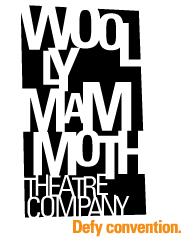 From Emmett Till to Trayvon Martin: A Town Hall Meeting on Black Bodies and American Racism “Our lives begin to end the day we become silent about things that matter.” – Martin Luther King, Jr. Woolly Mammoth Theatre Company was one of my first theatre homes. They taught me how to be a dramaturg, a craft which has served me well these past eight years. I have attended nearly every single production. I have stood in praise and enthusiasm of their programming, which reflects a commitment to diversity of form, gender, race, ability and sexual orientation. But I have never been more proud to be affiliated with them than I was this past Friday night when I took part in the town hall event. From the beginning, there was an immediate sense that folks needed to be a part of this conversation. They needed a safe, but charged place to engage and process, to validate and confront all of what they had been feeling in response to the recent verdict in the Trayvon Martin case in Florida. With the 50th Anniversary of the March on Washington upon us, now was the time for civic action and leadership. Woolly Mammoth took that the helm in our theatre community and executed it brilliantly. When I walked into the theatre, the energy of the room was palpable. It was hungry, passionate and urgent. There was a radiant sense of expectation, curiosity, and hope. Howard Shalwitz (Woolly Artistic Director) and Jocelyn Prince (Woolly Connectivity Director and Town Hall Facilitator) welcomed the panelists, facilitators, volunteers and more than 100 guests. We were invited to channel what we were feeling into action and change for the betterment of our society. We were encouraged to engage in an honest, open, and challenging conversation with local activists, academics, artists, policy makers and each member in the audience. In preparation for our convening, Jocelyn Prince worked with civic engagement expert, Michael Rohd, to shape our Goals and Rules for the evening: Woolly Mammoth Town Hall Goals
Woolly Mammoth Town Hall Rules
Once these rules and goals were agreed upon, we were then led in an Interfaith Prayer by Reverend Carolyn Boyd, Plymouth Congregational United Church of Christ. Her prayer served as a reminder that we have come together in the service of work that is greater than us. Click here to her powerful, healing and uplifting words. Then, poet and Woolly Claque Member, Ray Crawford delivered his beautiful, raw and captivating poem, Worthless. His poem was a reminder of how art can help us to contextualize an otherwise painful, disturbing and inexplicable experience. Next, Jocelyn facilitated the discussion with panelists: Reverend Carolyn Boyd, Minister of Organizational Development at Plymouth Congregational United Church of Christ; Louisa Davis, activist and Adjunct Professor of Religion and Ethics at Montgomery College; Jessica Frances Dukes, Woolly Company Member; Dr. Dennis B. Rogers, Lecturer in the Department of History and Government at Bowie State University; Gabriel Rojo, Site Manager, Identity Youth, Inc.; and Dawn Ursula, Woolly Company Member (and cast member in Woolly’s production of We Are Proud to Present…) These were the questions that were asked and the responses that really resonated: How has the outcome of the Trayvon Martin trial impacted you as a minister/activist/theater artist/academic? As a citizen? As a human being?
How would you situate the Trayvon Martin trail and verdict (as well as the ongoing national actions and dialogues in response to the verdict) within the context of the civil rights movement? Is there a linkage that you would draw between Emmett Till and Trayvon Martin?
What implications do the case and verdict have for ongoing issues in the DC community (racial profiling, police brutality, criminalization of marijuana, race relations, prison and military industrial complex, etc)? What role can DC citizens play in changing the societal conditions that contributed to the death of Trayvon and the acquittal of George Zimmerman?
Towards the end of the panel discussion, an interesting, profound and shattering point was raised about our collective understanding of Race: Success is about moving toward whiteness. This bears repeating (and perhaps even saying aloud): Success is about moving towards whiteness. There is a disturbing, frightening and undeniable truth to this statement that I feel resonating in conversations around the risk of producing plays by playwrights of color. From there, we had a brief group conversation where the audience had an opportunity to ask questions and share their own thoughts. What I found most valuable in this discussion was the sharing of essays, books and online resources:
From there, we broke out into smaller sessions for deeper investigation of these issues. We were tasked with identifying potential next steps and action plans for our own community. We were reminded to be patient, open, and generous with ourselves and others. Academics (Ray Crawford Jr.)
Activists and Policy Makers (Kymone Freeman)
Artists and Arts Workers (Jacqueline E. Lawton)
Youth and Youth Workers (Goldie Deane)
I’m writing this blog as I listen to the commemoration of the 50th Anniversary of the March on Washington. So, I will end where we began with an inspiring quote from Dr. Martin Luther King Jr.: "We are now faced with the fact, my friends, that tomorrow is today. We are confronted with the fierce urgency of now. In this unfolding conundrum of life and history, there is such a thing as being too late. Procrastination is still the thief of time. Life often leaves us standing bare, naked, and dejected with a lost opportunity. The tide in the affairs of men does not remain at flood -- it ebbs. We may cry out desperately for time to pause in her passage, but time is adamant to every plea and rushes on. Over the bleached bones and jumbled residues of numerous civilizations are written the pathetic words, "Too late." There is an invisible book of life that faithfully records our vigilance or our neglect. Omar Khayyam is right: "The moving finger writes, and having writ moves on." More than anything, “the fierce urgency of now” was the real power of the Woolly Mammoth Town Hall event. We all entered the theatre that night for different reasons. We all came from different life experiences. We all have different beliefs for how to solve the problems of systemic racism and injustice. However, we all have a clear understanding that NOW is the time for this work to happen and that we can only achieve great success by coming together as a unified force. 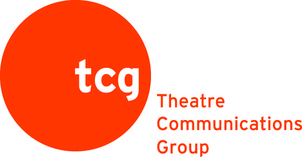 The following post is part of a blog salon series focusing on how theatre artists are responding to Trayvon Martin’s death, the trial and verdict, and the subsequent cultural response to those events. This series grew out of a series of discussion between myself, The New Black Fest’s artistic director Keith Josef Adkins, TCG's Associate Director of Communications August Schulenburg and TCG’s Director of Communications & Conferences Dafina McMillan. Please let us know if you'd like to contribute. GUS SCHULENBURG: How has the outcome of the Trayvon Martin trial impacted you as a theatre artist? As a citizen? As a human being? JACQUELINE LAWTON: As a theatre artist, it has cemented my desire to use each and every play that I write as a tool for social justice and change. Otherwise, the time and words were wasted. As a citizen, I am keenly aware that the struggle for civil rights is as much needed now as it ever was. What’s more, it is my duty, so long as I am alive on this earth, to do everything in my power to promote social awareness, race consciousness and compassion. I want to bring people together around these issues and encourage dialogue that moves us to a place of understanding, appreciation and respect for difference. As a human being, to be perfectly honest, I feel quite broken. Gus, if I wanted to have children, they would be brown. God help me, if they are boys. And there’s nothing, I can do to keep them safe … to keep them beyond the reaches of racism. GS: What actions are you taking, if any, to respond to that outcome? JL: At first, it was very difficult for me to respond. All I could think about was my brother and how this could have been him. I remembered the conversations my father would have with him about his behavior and attitude in the presence of whites. We were raised in East Texas … not too far from where, in 1999, James Byrd Jr. was beaten, chained by his ankles to the back of a pick-up truck and dragged to his death for more than two miles. Instead of responding, I read a lot of what was being written and listened to what was being said. I shared what resonated deeply with me on Twitter and Facebook. I connected with friends. The next morning in a fit of tears, I wrote a poem called, On the Morning After Not Guilty. I’m trying to respond … But a gunshot and shouts of no justice, no peace ring in my ears. I’m trying to respond to what has happened to Trayvon Martin … to his family … to the mothers of boys born with brown skin … to each of us across this nation. But a gunshot and shouts of no justice, no peace ring in my ears. I’m trying to respond to the fact that when I see young boys with brown skin on the street, on the metro, in the grocery store and in the classroom, I silently pray this prayer: Bless you, stay safe, keep your cool, and may you live long enough to see your grandchildren and a time when strangers don’t silently pray this prayer. But a gunshot and shouts of no justice, no peace ring in my ears. I’m trying to respond without remembering the cautionary words my mother and father shared with my brother when they taught him that his actions, words, glance and gaze could get him killed … not just for their intent, but for his brown skin. But a gunshot and shouts of no justice, no peace ring in my ears. I’m trying to respond without tears of pain, sorrow and disappointment to this egregious crime and miscarriage of justice. But a gunshot and shouts of no justice, no peace ring in my ears. I’m trying to respond in a way that moves this nation forward. But a gunshot and shouts of no justice, no peace ring in my ears. I’m trying to respond … But even that wasn’t enough… GS: How have you engaged, or will you engage, with those who feel differently about that outcome? JL: Yes, I have and am happy to continue doing so. Out of the blue, a woman I went to middle and high school with contacted me on Facebook. She accused me of hate mongering by sharing the articles and said that the only way race relations would improve in this country is if African Americans were taught not to make a distinction between the races. She said a number of other things as well and here this is what I wrote in response:
Then I went on to share a very personal story that I haven’t shared with anyone in a very long time: I remember once in 6th grade, when a mutual “friend” and her crew walked over to me after I had taken a drink from the water fountain. This friend said to me, “You know there was a time when you couldn’t drink out of the same water fountain as us.” I looked at her and said, “Yes, I remember. My parents told me about that.” Then she said, ” Don’t you wish you were white? Don’t you think it would be easier?” Now, as much as I knew it would be easier, I didn’t want to give her that truth. Instead, I said, “I want to be white as much as you want to be black.” The look of horror and disgust on her face taught me everything I needed to know about issues of race in America. We exchanged another round of emails and I responded with the following:
These issues are extremely complicated and larger than the two of us, but we listened to one another and spoke candidly. This is progress, but even that wasn’t enough … GS: What role does theatre have in changing the conditions that contributed to the death of Trayvon Martin and the acquittal of George Zimmerman? JL: With theatre, we can reflect the important issues, values, and challenges going on in society. I agree with Sarah Bellamy, Associate Artistic Director at Penumbra Theatre, who says that: “As image makers, we have an important role to play in moving audiences beyond superficial and stereotypical representations of peoples and cultures and toward three dimensional representations that encourage deeper learning with honor and respect.” I also agree with Dr. Manuel Pastor, director of the Program for Environmental and Regional Equity (PERE) at the University of Southern California, when he says “there is a need to push the conversation beyond that of self-expression to one of community building and democracy.” But in order for theatre to do this, we have to take responsibility for how to perpetually update the narrative: What theatre is now with regards to race, gender, ability, sexual orientation etc.? How is it reflective of the change that is happening in America? Theatres in this country who find themselves serving White, Black and Latino communities should be holding town hall forums and discussions around these issues. They should be commissioning local writers to capture the response of this moment in history so that lessons learned are discussed in depth and carried over to future generation so that such an egregious crimes and senseless loss of life never happens again. GS: How do the racial/cultural power dynamics of the theatre field challenge or reinforce the conditions that contributed to that outcome? JL: When theatres do not present work by playwrights of color or cast actors of color or hire people of color in leadership positions, this sends a clear message that our voices, experience and expertise are not welcome, relevant, respected or valued. In such instances, I feel that theatres are reinforcing the conditions that led to this outcome. We have to do better. Our season planning needs to reflect out 501c3 status to serve our communities. GS: So much of this work to make change grows out of the shining example of artists, cultural organizers and civil rights workers in the past and present. From whose example do you draw strength? JL: I am inspired by the efforts of Sarah Bellamy, Khanisha Foster, Ilana Brownstein, Adam Thurman, Otis Ramsey-Zoe, Shirley Serotsky, Megan Sandberg-Zakian, Al Heartley, and Andre Lancaster. I draw strength from Nina Simone, Audra Lorde, Sydney Poitier, Elizabeth Catlett, Maya Angelou, Toni Morrison, Jill Dolan, Derek Goldman, Gregg Henry, Jojo Ruf and James Baldwin. I am invigorated by the efforts of TCG. I have never seen an organization more committed to improving the conditions of diversity and inclusion in the American Theatre. The fact that their efforts are transparent, self-reflective and action-based is extraordinary to me. If you'd like to contribute your own post to one of these or any other TCG Circle series, please contact August Schulenburg, Theatre Communications Group's Associate Director of Communications, to learn how.
If you're interested in joining TCG's online year-round conference community, check out Conference 2.0. 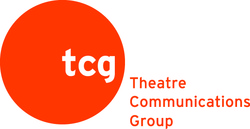 This post is a part of the Diversity & Inclusion blog salon that I led as part of the 2013 TCG National Conference: Learn Do Teach in Dallas. I am re-posting it here on my blog: Day Three of the conference is one that I’ll never forget. It was a hard day. I was taken to a deep, raw and honest place. I wasn’t ready for it. I wasn’t ready for how powerful and emotionally charged it turned out to be. At the same time, I should have seen it coming. It was not only inevitable, it was necessary for deep growth and lasting change to take place. I spent the morning processing my thoughts and typing my notes from the day before. I finished with moments to spare, but ended up missing the morning Diversity and Inclusion Learning Session and purely for selfish reasons. The day before, I learned from my dear friend, Jojo Ruf (General Manager, National New Play Network) that there was a Starbucks in her hotel. This was music to my ears, because I’d been craving a soy chai latte all week. Now, my hotel had a Peet’s Coffee, which it turns out Jojo happens to prefer over Starbucks. So, we made arrangement to buy each other’s caffeinated beverage of choice and in doing so, I was able to attend an Artistic Innovation Learning Session. But this was great; after all, I am a playwright! Living the Margo Jones Legacy: Breaking the Habit of New Play Development The speakers were Anne Cattaneo (Dramaturg and Director, Lincoln Center Theater Directors Lab), Anthony Clarvoe (Playwright, Edgerton Foundation), Ben Kryosz (Artistic Director, Nautilus Music-Theater), Jason Loewith (Artistic Director, Olney Theatre Center), Lisa Adler (Co-Artistic/Producing Director, Horizon Theatre Company) and Mara Isaacs (Producing Director/Founder, McCarter Theatre Center/Octopus Theatricals). The focus of the conversation was to examine ways in which the new play sector could continue to grow and support playwrights:
What I appreciated most about this session was the discussion around the trajectory of some of our more established playwright’s careers. It never hurts to be reminded that Arthur Miller, Christopher Durang, Sam Shepard and Tennessee Williams had to hone and shape their creative voices and artistic visions. These giants of the American Theatre grew into the playwrights they have become. It was a process that took time, faith and risk … three things the American Theatre needs to reinvest its energy and passion in. I’m glad to have had the opportunity to sit in on this conversation and meditate on my craft. In truth, I think it contributed to what made being a part of the next session so relevant, passionate and urgent. Diversity and Inclusion Homeroom, Session #3: Smashing the Glass Ceiling This session moderated by Carmen Morgan (Director, Leadership Development in Interethnic Relations) with panelists Jennifer Bielstein (Managing Director, Actors Theatre of Louisville; Vice President and Member of Diversity Task Force, LORT) and Teresa Eyring (Executive Director, TCG). Together, Teresa and Jennifer outlined the ways in which LORT and TCG were hoping to work together to build bridges and work more efficiently and intently towards a more Diverse and Inclusive American Theatre. LORT: Jennifer Bielstein LORT, as a management association, comprised a task force of managers from the pool of current LORT managers, to engage more deeply in its commitment to diversity and inclusion. The task force interviewed almost 20 people of color and recruiters in the field from LORT and outside – and the input from those interviews is what has shaped their process and thinking:
Jennifer ended her presentation with a great question and one that was asked across the conference: once you’ve set this as your goal, how do you measure success? What does it look like? TCG – Teresa Eyring For the past 52 years, TCG has had a long history and commitment to diversity that began in the early stages of the organization’s development. In fact, earlier movements are echoed in the current energy of growing the organization; specifically in terms of staff, board, grant making and publications. But what are the current challenges? Teresa said, “We have the opportunity to model a new world, rather than replicating existing weaknesses in society—such as institutional racism.” TCG wants to help facilitate change over time: Diversity and Inclusion Six Point Plan
Teresa and Jennifer then wanted to hear thoughts and questions from all of us. Carmen brilliantly and respectfully facilitated this conversation. These are the major issues that were raised:
In the midst of all of this, it hit me why these same conversations were being had over and over again and why no real change has occurred…just as there is the belief that audiences won’t come out to see plays written by or about people of color, there is a core belief that people of color are not qualified for executive level management or artistic positions. This is why people of color are constantly being told that we need training, professional development and special programs. I couldn’t take it. I stood up and shared my thoughts. I shared them through tears, deep sorrow and pain, and I can’t thank TCG enough for creating such a safe space for this place of raw truth to be shared. After I sat down, Carmen then asked us all to take a moment to reflect on what had just been shared. After which, two more young leaders of color shared their thoughts and experiences, which mirrored my own. They had gone through and successfully completed special fellowships, training programs and professional development for artists and administrators of color, but still professional opportunities were not being made available to them. Here’s the thing: these programs are essential. I mean, had Blake Robison (former Artistic Director of Round House Theatre/current Artistic Director of Cincinnati Playhouse), not nominated me as a TCG Young Leader of Color last year, I would never have been able to attend the TCG Conference last year. More than paying for housing, transportation, and the conference fees, the YLC program made me visible and gave me a sense of empowerment. Even though there was a loss of funding, TCG made it possible for many of us to attend the conference this year. As I said, this was a powerful day. I’m not the same for it and I’m grateful to everyone in that room and everyone who participated in the Diversity and Inclusion Arc for giving so much of themselves and for sharing so honestly where they are in their journeys. None of this work is easy, but that’s what makes it so necessary. I’m curious to hear from others who took part in this session or any of the sessions. Your experiences and perspective are essential. I’d love to hear your thoughts on these questions and any of the issues address over the course of the day. If you're interested in joining TCG's online year-round conference community, check out Conference 2.0. 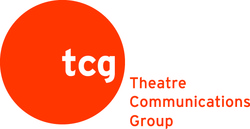 This post is a part of the Diversity & Inclusion blog salon that I led as part of the 2013 TCG National Conference: Learn Do Teach in Dallas. I am re-posting it here on my blog: Day Two of the conference was powerful, spirited and eye-opening. I was so energized from the day before and so I was open and ready to receive everything presented on Friday. I had no idea how necessary and impactful these sessions and discussion would be. I had no idea how much I would be shifted by… Race and Representation: The power of Theatre to Create a More Inclusive World led by Sarah Bellamy, Associate Artistic Director for Education at Penumbra Theatre. Before we go on, it should be known that Sarah is a true gift to the American Theatre. Her brilliant learning session was actually an excerpt of a larger workshop that she conducts around the history, evolution and impact of stereotypes. To begin, Sarah addresses the role and responsibility that theatre plays in either eliminating or perpetuating stereotypes:
To frame the conversation, Sarah posited that stereotyping is a process that relies on chains of meanings: fears and fantasies that manifest in myths. Stereotypes matter because they influence perception, which influences belief and finally access to opportunities. This is key. This is what we’re working to combat when we talk about diversity and inclusion. Next, we talked about the detrimental impact of stereotypes used as tools for comedy. This is when humor and racism is used to decide who is an “us” and who is a “them.” Sarah reminded us that:
Stereotypes act as a kind of currency within American culture. As humans we learn to sort and place value on sorting categorizing and accumulating, which is linked to capitalism. It was at this point that Sarah introduced us to the four D’s, which blew my mind and instantaneously shattered by heart:
With all of this work around stereotypes, Sarah reminded us that we have to chase the train of meaning. If we don’t understand the history of the images, then we will miss the meaning that’s been created. So when you see the image of watermelons on the White House, you understand immediate and irrevocably the incendiary intention of the message. As you can see, the session was comprehensive, challenging and necessary. There was a lot to unpack. A major question that was posed early in the session still resonates with me and deserves a great deal of meditation: how do we combat racism in a world that looks progressive? A Conversation with Ayad Akhtar with Gabriel Greene Novelist, screenwriter, playwright and winner of the 2013 Pulizter Prize for Drama for Disgraced, Ayad Akhtar is a passionate, eloquent and dynamic speaker. It was hard to take notes during this session, because I want to absorb everything he said. Fortunately, you can listen to it here. It was inspiring to hear his journey to theatre and his writing process. He grew up in a household where theatre was not a part of his growing up experience. In fact, the television show Dallas was the family’s entertainment of choice. While he knew that he wanted to be a writer when he was 15, he fell in love with theater in college. He started out writing outside of himself in a European tradition. He wanted to write something universal and didn’t think that his experiences would relate to others. As he grew older, he had a growing awareness that he was running away from something. It became clear to him that he wasn’t writing what he knew. He wasn’t writing about his identity, but that has since shifted. Towards the end of the interview, Ayad revisited Aristotle’s definition of catharsis: “the expression of emotion through pity and terror. Terror is key and is defined as when the Furies arrived on stage, women miscarried in the aisle.” This is the type of visceral response that is both religious and mass, and it’s what he strives for in his writing. It was really great to be reminded of this. By the way, I just finished reading his novel, American Dervish, which follows Hayat Shah a young Pakistani American who falls in love, discovers his faith and works through the confusion of both forces in his life. It was magnificent and absorbing. I read it in two days. His Pulitzer Prize willing play, Disgraced, will be published in the July/August issues of American Theatre Magazine and I can hardly wait. Also, he participated in an interview with Caridad Svich as part of TCG’s conversation around Artistic Innovation, which can be read here. Diversity and Inclusion Homeroom This year, the TCG Conference’s had four focused programmatic arcs--Diversity and Inclusion, Audience Engagement, Financial Adaptation and Artistic Innovation. Each day, we were divided out into homeroom sessions along our respective arc. For the Diversity and Inclusion arc, we were asked to submit have a diversity and inclusion challenge that we were wrestling with, if we wanted to hear advice and feedback from others. Understanding that Diversity and inclusion begins with awareness and advocacy, but that it must shift to action, these homerooms were a great way to strategize and build allies in our efforts. Here are some of the questions that were raised:
As these questions were asked, we quickly realized that we weren’t alone in our struggles. Here are some of the useful suggestions that were made:
We ended the conversation reflecting on Dr. Manuel Pastor’s presentation from the day before. He reminded us that the importance of theatre to social discourse. With theatre, we can reflect the important issues, values, and challenges going on in society. This is the kind of discourse that can only happen in the theatre. But in order for theatre for theatre to do this, we have to update the narrative: What theatre is now with regards to race, gender, ability, sexual orientation etc.? How is it reflective of the change that is happening in America? Always, I’d love to hear your thoughts on these questions and any of the issues address over the course of the day. If you're interested in joining TCG's online year-round conference community, check out Conference 2.0. |
My BlogI'm a playwright, dramaturg, and teaching artist. It is here where you'll find my queries and musings on life, theater and the world. My posts advocate for diversity, inclusion, and equity in the American Theatre and updates on my own work. Please enjoy!
Categories
All
Archives
June 2020
Reading List
|
